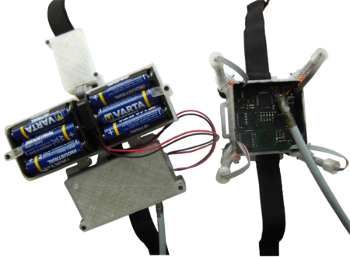Here you can find documentation and technical details for the miniaturized stand alone open Near InfraRed Spectroscopy (NIRS) hardware.
We are aware, that the provided design is far from perfect and can be further optimized in several ways.
However, with the presented version having passed several evaluation and verification steps and proving full functionality, we feel that the presented documentation and materials for this open NIRS instrument can significantly help anybody who is designing his own NIRS hardware from scratch.
This instrument should therefore not be viewed as complete in the sense that simple rebuilding is the first choice (even though this is possible and will result in a running NIRS instrument) but as a guidance for further designs that will then be able to profit from the experience and building blocks of the hardware, software and mechanical concept presented here.

For the most compact, revised and up to date (Jan. 2015) documentation of the openNIRS system, please see and refer to the following publication:
von Lühmann, Herff, Heger and Schultz (2015), „Towards a wireless open source instrument: functional Near-Infrared Spectroscopy in mobile neuroergonomics and BCI applications„, frontiers in Human Neuroscience, doi:10.3389/fnhum.2015.00617
For a next generation hybrid EEG-fNIRS-Accelerometer architecture that is built on top of the openNIRS technology and significantly increases hardware performance, miniaturization and functionality, please see the following new open access M3BA publication. However, if you want to use this commercially, please note that the M3BA design is patented. Feel free to contact us on the M3BA page on this website for questions regarding licensing options.
von Lühmann, Wabnitz, Sander and Müller (2016), „M3BA: A Mobile, Modular, Multimodal Biosignal Acquisition architecture for miniaturized EEG-NIRS based hybrid BCI and monitoring„, IEEE Transactions on Biomedical Engineering, doi:10.1109/TBME.2016.2594127
Both the openNIRS and M3BA architectures are part of the following PhD thesis, where you can also find applications and experiments, and novel multimodal signal processing methods based on machine learning:
von Lühmann, Alexander (2018), „Multimodal instrumentation and methods for neurotechnology out of the lab „, Berlin Institute of Technology, doi:10.14279/depositonce-7445
A far more detailed documentation of the openNIRS hardware that is however less up to date than the openNIRS publication in frontiers can be found here:
| 1 | Introduction | 1 | ||
| 1.1 | Motivation | 1 | ||
| 1.2 | Objective | 2 | ||
| 2 | State of the Technology | 3 | ||
| 2.1 | Brief Overview of History | 3 | ||
| 2.2 | NIRS Principle and Signals | 4 | ||
| 2.3 | NIRS Interrogation Approaches | 8 | ||
| 2.3.1 | Continuous Wave NIRS | 8 | ||
| 2.3.2 | Frequency Domain NIRS | 8 | ||
| 2.3.3 | Time Division NIRS | 9 | ||
| 2.4 | Theoretical Background | 10 | ||
| 2.5 | Review of existing fNIRS Technology | 12 | ||
| 2.5.1 | NIR Light Emitters | 13 | ||
| 2.5.2 | NIR Light Detectors | 14 | ||
| 2.5.3 | Optical Conduction | 16 | ||
| 2.5.4 | Signal Amplification | 16 | ||
| 2.5.5 | Probe Designs | 16 | ||
| 2.6 | Fields of Application | 17 | ||
| 3 | System Design | 19 | ||
| 3.1 | Preliminary Remakrs | 19 | ||
| 3.2 | Noise, Crosstalk and Error Sources | 20 | ||
| 3.2.1 | Noise Errors | 20 | ||
| 3.2.2 | Crosstalk | 22 | ||
| 3.2.3 | Other Error Sources | 22 | ||
| 3.3 | System Concept | 23 | ||
| 3.4 | Hardware Design NIRS Module | 26 | ||
| 3.4.1 | NIR Light Emitter | 26 | ||
| 3.4.2 | NIR Light Sensor | 28 | ||
| 3.4.3 | Amplification, Lock-In Modulation and Demodulation | 30 | ||
| 3.4.4 | Current Regulators | 34 | ||
| 3.4.5 | Microcontroller Unit | 38 | ||
| 3.4.6 | General Remarks on Layout and Design | 39 | ||
| 3.5 | Hardware Design NIRS Mainboard | 40 | ||
| 3.5.1 | Power Supply | 40 | ||
| 3.5.2 | Analog-to-Digital Conversion | 41 | ||
| 3.5.3 | Communication/Bluetooth Transmission | 42 | ||
| 3.5.4 | Microcontroller Unit | 45 | ||
| 3.5.5 | General Remarks on Layout and Design | 46 | ||
| 3.6 | Safety Aspects | 47 | ||
| 3.7 | Software Design | 48 | ||
| 3.7.1 | NIRS Module | 48 | ||
| 3.7.2 | NIRS Mainboard | 51 | ||
| 3.7.3 | Console Userface and Control Commands | 56 | ||
| 3.7.4 | LabView User Interface | 56 | ||
| 3.8 | Mechanical Design | 61 | ||
| 3.8.1 | NIRS Module Attachment | 61 | ||
| 3.8.2 | Mainboard and Batteries | 64 | ||
| 4 | Evaluation and Analysis | 67 | ||
| 4.1 | Evaluation of Hardware and Design | 67 | ||
| 4.1.1 | PWM Signal | 67 | ||
| 4.1.2 | Power Supply | 68 | ||
| 4.1.3 | Current Regulators | 69 | ||
| 4.1.4 | Lock-In Detection | 70 | ||
| 4.1.5 | System Drift | 73 | ||
| 4.2 | Physiological Verification of the System | 74 | ||
| 4.2.1 | Qualitative Physiological Signals: Pulse and local Blood Pressure | 74 | ||
| 4.2.2 | BCI Trials: Mental Arithmetics | 75 | ||
| 5 | Results and Discussion | 79 | ||
| 5.1 | System Overview | 79 | ||
| 5.2 | Scope and Limitations | 81 | ||
| 6 | Summary and Outlook | 83 | ||
| A | Appendix A | 87 | ||
| List of Figures | 103 | |||
| List of Tables | 105 | |||
| References | 107 |